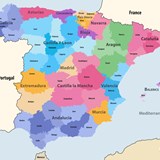MARKET REPORT
Spanish Property Market 2025
Click on any of the images to open larger versions.
Introduction
When I update our Spanish Property Market reports at the start of a new year I’m always at a disadvantage of not having full year statistics to hand as the key numbers for the overseas sector of the property market are published half-yearly. The January - June numbers appear in October but for July - December we have to wait until April of the following year. After seeing the 1st half figures I predicted the full year 2024 total would probably equal 2023, possibly even better it, but not by much. We now know the 2024 total of overseas buyers in Spain not only beat 2023 but sailed past it easily, growing from 131,288 to an all-time high of 139,102, a 5.9% increase.
One thing I think we can be certain of is that the distortion caused by the Covid-19 pandemic has now been washed out of the statistics. The reality was that what looked like a boom in the numbers of overseas property buyers in Spain in both 2021 and 2022 was just a mirage, as I explained in this blog. Not a boom, just tens of thousands of people who would have shown up in the statistics for 2020 and 2021 but didn’t because of lockdowns, entered the market more or less simultaneously, playing pandemic catch up together with normal new annual demand. So the overseas market was never increasing at 20%+ annually as the statistics for those years seemed to suggest because they were being compared with the big drops that occurred in 2020 and 2021. In reality, if the market had just continued to grow by 1% - 3% per year, as it had been doing for several years before the pandemic, it would have been in exactly the same place in terms of the number of overseas buyers.
And that’s what these latest figures confirm, continued upward trend of overseas buyers in Spain in 2024. Not only that, the annual growth rate of nearly 6% is about 3 times the rate at which it grew in the immediate pre-pandemic years and it’s clear we are dealing with a much bigger market in 2025. In fact, compared with 2016, the first year that foreign buyer numbers got back to the levels seen at the top of the market just prior to the 2008 crash, 2024 buyer numbers were 59% higher. It seems overseas demand is stronger than ever and growing and this raises one of the most important issues in the current market, the imbalance between supply and demand and I will cover this topic in this report. And I will also try to answer the question: where are they all coming from?
Where The Numbers Come From
The Notaries are my preferred source for a straightforward count of transactions numbers, with breakdowns by nationality, autonomous regions and price per square metre. This format started in 2007 so gives an interesting overview of international buyer patterns from just prior to the 2008 market meltdown and the subsequent recovery. These are published half-yearly.
In addition, MITMA (Ministerio de Transportes y Movilidad Sostenible) is good for a more local breakdown by province and municipality and published quarterly. However, they do not count by nationality, foreign buyers are counted as a block divided not by where they come from but by whether they are resident or non resident.
In my view, stats from the Property Registries can be ignored as they count when a property is inscribed in the registry, not when it completed in front of the notary and inscriptions may be weeks or even months after completions. At the end of 2024 clients of The Property Finders purchased a property owned by a Spanish Limited Company and getting it inscribed in the Land Registry after it had been taken out of company ownership took two months. So, if a property purchase takes place in front of a notary in August but doesn’t get registered until October, is that a statistic that belongs in August, which is when the notary would count it, or October, which is when it would show up in the land registry. Is it a Q3 transaction or Q4? As a result of these discrepancies, the Notaries and Property Registry statistics always differ and not by a little. They are usually out of sync by 25%+.
I update this report regularly throughout the year and I also blog and post the latest news from the Spanish property market on social media so do make sure to follow us. To understand where the property market now is it helps to know where it’s come from so I’ll start with a brief resumé.
The Notaries are my preferred source for a straightforward count of transactions numbers, with breakdowns by nationality, autonomous regions and prices per square metre. In addition, MITMA is good for a more local breakdown by province and municipality.
Where We Were
At the peak of the Spanish Property Market bubble which burst as a result of the 2008 global financial crash the highest market share attributed to overseas buyers was 8.9%. For several yeas prior to the crash Spain had constructed over 800,000 new units per year, more than the UK, France and Germany combined. The market was fuelled by cheap credit and speculation and the bubble was always going to burst at some stage, the global meltdown just helped it on its way. However, the almost complete wipeout of Spain’s construction industry is still impacting the property market nearly 20 years later as demand outstrips supply, affecting both domestic and overseas purchasers.
Growth in the overseas sector got going again in 2012 while, in contrast, the domestic market continued to shrink until 2014. After 8 years of sustained growth by the end of 2019 overseas buyer market share had more than doubled to 19% of the overall market. Furthermore, in terms of overseas buyer numbers this sector of the market was 77% bigger than at the pre-2008 peak. In contrast, the domestic market experienced a much slower recovery over the same period. When Covid-19 arrived Spain’s domestic property sector was still 40% smaller than it was a decade before.
Before starting to dig into the statistics and apply them to the property market and related issues it’s perhaps worth taking a look at why Spain is such a draw for so many overseas buyers.
The Property Market - Why Spain?
For lifestyle Spain is hard to beat, it’s relaxed and easy-going, safe and child-friendly. Life expectancy has increased by 12 years since 1970 and at an 83.99yrs average, it is one of the highest in the world.
The climate suits all tastes. It ranges from four seasons with a proper winter and lots of snow in the north to the sub-tropical south. The micro-climate zones on the Mediterranean coasts of Andalucía have the best winter temperatures on the European mainland. Spain’s beaches, marinas and tourist boats have more Blue Flags than any other country in the world, a total of 747 in 2024. In fact, Spain has occupied the top spot every year since the scheme began in 1987.
Living well is affordable with food and drink prices below the E.U. average,(Source: Eurostat 2023). Spanish cuisine is world-class and currently, Spain has 3 restaurants ranked in the top 5 in the world. (Source: The World’s 50 Best Restaurants). For the cultural tourist Spain has some of the oldest cities in the world and 49 UNESCO World Heritage sites. This puts it in third place globally, behind Italy (58) and China (56).
In November 2023, Forbes magazine reported on the annual poll by InterNations, a global community of people living and working abroad, which ranks the best cities in the world to be an ex-pat. For the first time ever, the first 3 positions were occupied by Spanish cities; Málaga was ranked #1, followed by Valencia and Alicante. (Source: Forbes). And in 2024, the same organisation ranked Spain 4th in the list of best countries for ex-pats, the only European country in the Top 10. Then, in January 2025, the annual New York Times list of 52 places to visit during the year, ranked Canfranc (Aragón) at number 24 and Montserrat (Cataluña) 41. (Source: New York Times).
Sports and outdoor enthusiasts are spoilt for choice. Golf, tennis, equestrianism, skiing, wind & kitesurfing, mountain biking, rock-climbing, hiking, fishing - the list goes on and on. The result is that Spain has a quality of life that’s hard to beat, appealing to both foreign second home owners and permanent residents from overseas. None of what has persuaded millions of foreign property buyers to choose Spain in the past has changed. The sun is definitely still shining.
Sports and outdoor enthusiasts are spoilt for choice. Golf, tennis, equestrianism, skiing, wind & kitesurfing, mountain biking, rock-climbing, hiking, fishing - the list goes on and on. The result is that Spain has a quality of life that’s hard to beat.
Spain Needs Overseas Buyers
Whether you look at transaction numbers or market share it’s clear international buyers are an important part of the overall Spanish Property Market. For the three years prior to the pandemic the number of overseas buyers had topped 100,000 with an annual average of 102,000. With the record-breaking 2024 figures confirmed, the market in 2025 moves forward with 37% more transactions than pre-pandemic. In contrast, the domestic sector shows an increase of 26% over the same period so although that sector is showing growth it’s been at a much slower rate.
We now know that there were 139,102 international buyers in Spain in 2024. equivalent to 20% of the total Spanish market. But it’s not just the numbers and market share that give overseas buyers a prominent place in the property market, it what they spend and we have to dig deeper into the statistics to get to those figures.
In total, there were 131,388 foreign buyers in Spain during the year, equivalent to 20.9% market share.
Unpicking The Statistics
Until the post-pandemic surge of overseas buyers had died down it was difficult to see what the new normal might look like. In my review of 2022 I said that we needed to see two more years of statistics to make a judgement and I believe we are now at that stage.
These latest statistics clearly show the overseas sector of the Spanish property market has become a much bigger cake over the last decade. In fact, in the decade since 2015, nearly 1.1m overseas buyers have invested in the Spanish property market, the actual figure being 1,074,231. In addition, the traditional markets from northern Europe have been joined by other nationalities that barely registered previously and the signs are that these groups continue to grow. And while it was the case that much of the overseas sector was based on second home ownership, it’s now clear the balance has changed, with more purchases linked to permanent residence, either as retirees or working. For example, two decades ago 77% of British buyers were second home owners, today that has fallen to 60% with 40% classed as resident foreign owners. And in just the last decade there’s been an even more noticeable shift in the overall overseas sector; in 2015, 51% of foreign buyers were non-resident second home owners, the 2024 statistics show that’s dropped to 41%.
We know that the Covid-19 pandemic changed a lot of things, not least the possibility for some of working from home and working from abroad. If home and abroad can be combined in Spain then the property market is likely to benefit long term.
The New Normal?
Overseas buyers have made up approximately 20% of the overall Spanish property market for several years and 2024 was no different at 19.9%. However, the statistics also highlight that the overseas market is much more important in some locations than others, with much higher market share. It turns out that a key factor in where overseas buyers spend their money is the Mediterranean.
Spain is divided into seventeen autonomous regions but only five have Mediterranean coastlines; Cataluña, the Comunidad Valenciana, Murcia, Andalucía and the Balearic Islands and they dominate the overseas sector. The latest figures show that 73.6% of all foreign buyers in 2024 bought in one of these five regions, a total of 104,395. The pull of the Mediterranean is even clearer in the case of those autonomous regions with some coastal provinces and some inland. Andalucía is a good example of this; four of its eight provinces have Mediterranean coastline and four do not. The four Mediterranean coastal provinces, Almería, Granada, Málaga and Cádiz, accounted for 87% of the 25,573 foreign purchasers in the region in 2024.
And it’s the same in Cataluña, where the three provinces with Mediterranean coastline - Barcelona, Tarragona and Girona - dominated the overseas market with 87.9% of foreign buyers, leaving inland Lleida with just 916.
In fact, when the statistics for the overseas buyer sector are unpicked we are really only looking at six regions, the five with Mediterranean coastlines and the Canary Islands. Between them they accounted for 82% of the overseas market in 2024
In reality, when we unpick the overseas buyer sector we are actually only looking at 6 regions. These hotspots are so dominant that the 2024 statistics show that 80.1% of overseas buyers bought in one of them.
The Nationality League Table
The MITMA statistics don’t count by nationality, foreign buyers are split into resident or non-resident foreigners groups, no further details. However, the notaries started counting foreign buyers by nationality in 2007. Prior to that we didn’t know much other than that there were lots and lots of Brits compared with other nationalities. In fact, starting in the 1960s, the British made up about 80% of all foreign buyers in Spain until around the mid-1990s when other nationalities began to enter the market in greater numbers. However, we didn’t have an official count until 2007 and every year since then the British have been the nationality league leaders.
Although I keep expecting to see the British knocked off the top spot they are hanging in there. The nationality breakdown for 2024 left them in 1st place with 11,912 purchases, 8.6% of all foreign buyers but 4.4% fewer purchases than in 2023. So far, so normal, but there are big changes happening lower down the league table. Previously, I would have expected to see either the French or Germans in the next two spots, they switched around on a regular basis but not any more it seems. Buyers from Morocco took 2nd place, with 10,512 purchases and 7.5% foreign market share, pushing the Germans (9,360, down 5.75%) into 3rd place, Romanians (8,858) were 4th, Italians (8,398 up 4.4%) 5th and the French slipped to 6th (7,849, down down 8.75%).
What really stands out about the nationality statistics now is just how much some markets have expanded in the 18 years since 2007 when the notaries started collating where the overseas buyers were coming from. For example, in that year there were just 1,003 German buyers against 9,360 in 2024 and only 330 from the U.S. versus 2,975 in 2024, a 15.75% increase from 2023. Back in 2007, Poland didn’t even register as a separate country, they came under the ‘EU others’ group but in 2024 they experienced the biggest increase y-o-y in the nationality league, up 36% with 5,947 buyers. And while the German market has grown steadily over the years to its current level the U.S. market growth has been more explosive, up 124% since 2019.
So having looked at where all these international buyers are investing their money and identified who the major players are, it’s time to focus on what they spend. This produces a rather different league table.
Prior to 2007 we didn’t know much other than that there were lots and lots of Brits compared with other nationalities. Although I keep expecting to see the British knocked off the top spot they are hanging in there.
Foreign Spending Power
Buyers from overseas have always spent more that domestic buyers. These 2024 figures show the average spend per square metre for domestic buyers was €1,686 while the average for foreign buyers was €2,306, 36% more. And the difference is even more marked if overseas buyers are separated into residents and non-residents; the average spend of a non-resident foreign buyer was €2,966, 76% higher than the domestic average. In the case of British buyers, who are far from the biggest spenders among overseas buyers, they spent 39% more pm2 than domestic buyers if taken as one group. However, if the British buyer is a resident then that difference falls to 14.8% while a non-resident British purchaser spent, on average, 54% above the national average for domestic buyers.
The Big Spenders
Buyers from the U.S. took the top spot for the first time in the high-spenders nationality league, averaging €3,318 pm2, against the Swedes €3,312 pm2. However, non-resident buyers from the U.S., spending on average €3,749 pm2, opened up a bigger lead over the Swedes and other all E.U. nationals but were obliterated by non-resident buyers from Venezuelan whose average spend pm2 was €6,807. But before estate agents start planning expensive marketing campaigns to attract more wealthy Venezuelans into the market they should take note that the grand total of non-resident buyers from Venezuela in the whole of 2024 was 48. The number of resident Venezuelans entering the market was only 1,641 and they spent 18% less than the domestic average. So, breaking this group down into resident and non-resident sections it turns out that while the 2.8% who were non-residents spent way more than everyone else in terms of price pm2, obviously purchasing at the very top of the market, the 97.2% who were residents spent considerably less than Spanish buyers. It’s safe to assume that they weren’t buying in the traditional Mediterranean mainland coasts and island hotspots. Furthermore, by breaking down all overseas buyers into resident and non-residents groups, it becomes clear it’s the non-resident purchasers from overseas who are the highest spenders in the Spanish property market, while resident foreigners have budgets more closely aligned with the average domestic buyer and, in some cases, way below it.
The Low Spenders
Those nationalities who are overwhelmingly residents in Spain dominant the league of low spenders, well below the average spend of domestic buyers. They are more likely to be economic migrants buying in towns and cities and not on the Mediterranean coasts. A good example would be the Moroccans, the second most numerous in the nationality league table in 2024 with 10,512 purchases, an annual increase of 11.75%. 1.9% were non-residents, a grand total of 207 and they spent on average €2,790 pm2, very close to the average spend for all non-resident foreign buyers and 7% more than the average non-resident Brit. However, it’s the 98.1% resident Moroccans that really mess the figures up - their average spend pm2 was just €694, less than half the average spend of Spanish buyers. And it’s the same in respect of Chinese buyers. The 10.5% non-resident Chinese buyers outspent the Swedes and Germans while the 89.5% who are residents were more or less in line with the domestic average. Other nationalities whose resident to non-resident ratio is way above the overall overseas sector include Romanians, Bulgarians, Colombians, Ecuadoreans and Venezuelans and in all cases the average spend pm2 is close to or well below the national average.
The Regional Hotspots
In terms of overseas buyer spending power all the overseas buyer hotspots saw increases in the average amount paid by foreigners per square metre in 2024. And to get a sense of just how much prices have risen recently, I’ve compared 2024 per m2 prices with pre-pandemic 2019. In the case of Andalucía it’s up to €2,515 pm2, a rise of 41% and Cataluña was up 23.5% to €2,556. Meanwhile in the Comunidad Valenciana, the increase to an average of €1,826m2 means prices have risen 34% since 2019. And in those same three locations the rise since 2023 is 11.7%, 3.3% and 7.9% respectively.
And the most expensive autonomous region in the Mediterranean? That would be the Balearics. After breaking through the €4,000 pm2 barrier in 2023 it has risen further in 2024 to €4,676, up an astonishing 50.2% since pre-pandemic 2019. In contrast, there is just one Mediterranean region where the average price paid by foreign buyers was even below the domestic buyer average and that was Murcia, on €1,318 per m2
I’ve already commented on the statistics which show how the overseas sector of the Spanish Property Market is concentrated is just a handful of regions. And within those regions it is further fragmented at the provincial and municipal levels. A good example of this is Andalucía. Not only is it Spain’s largest autonomous region it is one of the most varied. It has both Mediterranean and Atlantic coasts, a huge, mountainous interior and five of Spain’s most historic cities; Cádiz, Málaga, Seville, Granada and Córdoba. In addition, this one region accounts for 20% of all property transactions in Spain. So, in property terms it really has something for everyone but foreign sector activity is far from evenly spread. In reality it is actually concentrated in just a few locations.
Andalucía has eight provinces and while the 2024 overseas market share of 18.5% across the whole region was below the 20% national average it turned out that in Málaga province. which really means the Costa del Sol, foreign market share was 38.4%, just ahead of the Balearics where it represented 37.8%. And looking at the Comunidad Valenciana, 26,118 of the 41,442 foreign buyers in this region bought in just one province: Alicante, representing 63% market share. (Source: MITMA)
Tourism & Rental Demand
The total of overseas visitors to Spain in 2024 broke through the 90m barrier for the first time with ease, reaching 93.8m, retaining Spain's position as the second most visited country in the world. And if the 2025 numbers increase at the same level as in 2024 then the 100m barrier is looking a bit fragile. In addition, not only are the numbers up international tourists are spending more, an increase of 16% compared with 2023, totalling €126.282 billion. Does tourism have an impact on the property market? Very definitely as almost all have been tourists for years before they decide to purchase.
One reason for these extraordinary figures is that there are many more visitors out of the high season summer months. For example, the December 2024 total was 5.3m, January 2025 saw 5.1m and February 5.4m so it seems that 5m+ in low season months is the new normal. A decade ago around 3.5m a month was expected in January and February. Another factor behind the surge in numbers is the wider spread of nationalities, with strong growth from newer markets while the traditional, long-established markets, such as the British, Scandinavian and German markets remain the leaders. As with the nationality league table for property buyers the British lead the pack and by a big margin.
The statistics indicate that about 25% of international visitors looking for somewhere to stay do not stay in hotels, preferring to privately and current rental yields make letting a property to the tourist market in Spain an interesting option. And not just for the buy-to-let investor because although not all foreign owners are part-time landlords many are. They look for rental income to cover essential maintenance and running costs and taxes. Obviously there are many variables but the best gross yields can be as high as 10% and sometimes even higher for a large, top quality detached house in a prime location. Apartments and townhouses near the beach can return 6% - 8% gross, assuming a luxury interior. Typically, a quality property in a prime location will generate a higher yield in the short-term holiday market than the same property let long-term, in the region of 3% - 5% better.
However, there are always exceptions to the rule and growing demand for long-term rentals at the top end of the market can produce a gross yield similar to the short term yield. One of The Property Finders clients is seeing a 2019 purchase generating a gross yield of 8% as a long-term let. And just as the highest activity levels are at the top end of the property market so it is in the rental sector. Properties priced at €10,000 - €20,000 and up per week had no trouble finding takers in 2024 and high season weeks were fully occupied.
But a word of caution. It is clear the mood is changing and if rental income is part of your buying strategy then I recommend you proceed with caution. City centre licences will be strictly limited and may disappear altogether- in 2024 Barcelona announced a total freeze from 2028 and Málaga’s attitude hardened in 2024, new restrictions coming thick and fast. In addition, away from the city centres, it seems likely that more apartment complexes will vote to limit or ban short term holiday lets, leaving detached houses and townhouses as the best bet for rental income. For more on the issues and proposed solutions see recent blogs here:
The statistics indicate that about 25% of international visitors looking for somewhere to stay do not stay in hotels, preferring to privately and current rental yields make letting a property to the tourist market in Spain an interesting option. However, it is clear the mood is changing and if rental income is part of your buying strategy then I recommend you proceed with caution.
Who Is Buying What
For reasons I have never quite understood, foreign buyers are like moths to a flame if new-build is available, even when the location is inferior. The fact is there is very little raw building land available in the very best locations, it was built on years ago. Consequently, it follows that much of the new-build activity is not in prime locations. In addition, plots and constructed square metres are being squeezed in comparison with resale product.
I realise many buyers are not looking to make a huge profit in the short-term, they’ve made a life-style purchase. However, I’ve yet to meet one who is happy with the idea of a loss even before they’ve got the keys. In fact I think some buyers have been paying such inflated prices for new build properties that they may never see a return on their investment no matter how long they hold it. The discrepancy between new-build and resales prices in the current market is as extreme as I have ever seen in over 25 years in the property business in Spain.
I believe the main reason for this discrepancy is the legacy of the almost total destruction of the Spanish construction industry after the 2008 meltdown. Following years of excessive building, up to 800,000 units annually, Spain is currently completing around 90,000 units per year, about 40% below what is needed to cover new household formation, never mind demand for second homes from both domestic and foreign buyers, plus the rental investment sector. In October 2024 the Bank of Spain estimated that Spain is lacking 600,000 properties to cover new household formation since 2021, when it says the demand/supply ratio became seriously uncoupled. New household formation is currently around 265,000, a figure predicted to rise each year between 2024 and 2028 to around 330,000.
People can’t buy what isn’t there. A deficit in the new-build supply side inevitably puts pressure on the resale sector. Even before Covid-19 arrived there was a supply side deficit in the quality resale sector in prime locations and this has been exacerbated by the increase in international buyers entering the market over a short time period without a similar surge in supply. And what they are looking for, that is, high quality properties in top condition in prime locations is precisely what is in such short supply and I don’t see the demand/supply imbalance changing any time soon.
Buying Right in 2024
My advice to potential buyers in Spain is the same as ever. The location must always be key. Shiny new stuff, whether it’s a house or an apartment, something on the coast, the city or in the country, never trumps location. Always get the location right and then do the best with the available budget even if that means adjusting expectations. For example, several recent clients of The Property Finders have chosen a semi-detached property in order to stay in a really prime location. In my view, that is always the best decision. If they had stuck with their preference for detached they needed to accept an inferior location to stay in budget. Never compromise on location.
My advice to buyers in 2025 is do not obsess about new-builds, especially if not located in prime positions. Many are not. Consider equivalent resales, calculate the price per m2 to include any renovation if it’s needed. Then you can take an informed view on what makes the best financial sense. The result will almost certainly be a lower price, a bigger property and, most important of all, a superior location.
Don’t buy anything that is blighted. Roads tend to get busier over time so if it’s noisy now it will only get worse. If there is a mobile mast in view assume there will be more as the tendency is for them multiply. Electricity pylons are also a big no-no. We can assume new housing will increase in the long term. So it's essential to be aware of local planning issues and what might be in the pipeline. Already, in some areas I can count twenty cranes while standing still. If there is vacant land nearby find out with absolute certainty what, if anything, can be constructed. The selling agent saying it is green zone is just not good enough. Why risk losing a fabulous view?
And when I am assessing properties for my clients I always ask the following questions. If circumstances change and they need to sell quickly is the price right to enable them to do that? Secondly, is this a property for which there will always be demand irrespective of market conditions? One thing is certain; there will always be demand for top quality in prime locations. It always has been, still is and always will be about location.
The idea that the Spanish property market would experience a post-pandemic meltdown, similar to the market crash of 2008, quite clearly was wrong. In contrast, it has enjoyed increased interest and not just from long-established markets of British, Scandinavian and other European nationalities but from all over the world and it is now a truly global market. As already mentioned, overseas demand is pushing market share in the most prime locations way beyond the national average of 20%. The Spanish property market would certainly be in a very different place without overseas buyers.
And as to where prices are going in 2025, it really comes down to the demand/supply imbalance and I think we can be certain that if demand remains as strong as it is now and supply stays limited, prices are going in one direction only and that’s up. Nevertheless, if you buy at the right price in a prime location, Spanish property is still relatively affordable. There's potential for substantial capital growth in the medium term and excellent rental yield potential. The sun continues to shine and the quality of life is rated one of the best in the world. And there’s no doubt in my mind that with the WFH and WFA options becoming a reality for many more people post-Covid, that home will be in Spain.
©Barbara Wood
The location must always be key. Shiny new stuff, whether it is a house or an apartment, something on the coast, the city or in the country, never trumps location. Always get the location right and then do the best with the available budget even if that means adjusting expectations. Never compromise on location.
view our socials
© 2025 The Property Finders, International Property Search & Acquisition Services. All intellectual property in the design, images and text of this website are and will remain the property of The Property Finders. Any infringement of our rights will be pursued vigorously.
GDPR 2018 - We guarantee the personal data entered in the contact form will only be used for the purpose of replying to your enquiry and will not be shared with any other company, service or provider






